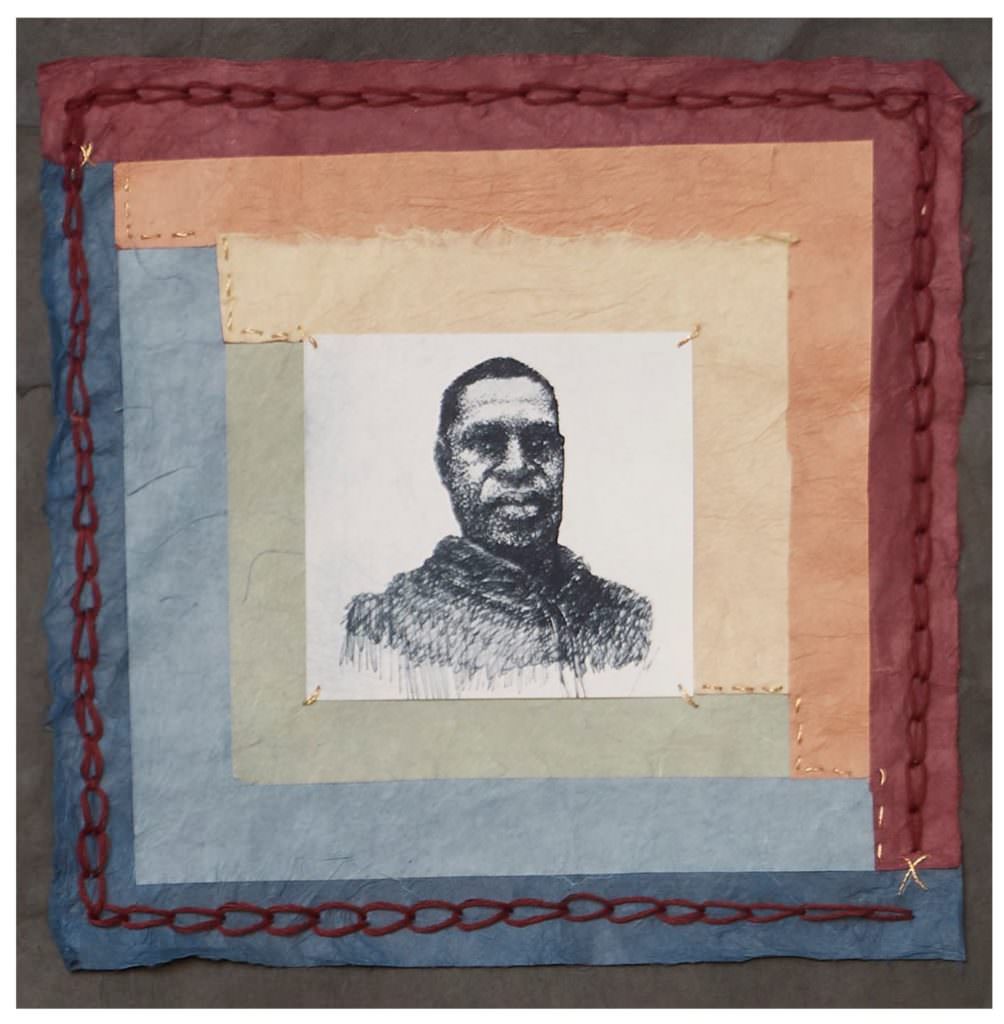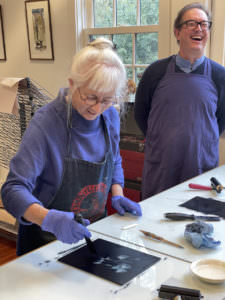Enjoy our conversation with artist Lisa (Elizabeth) Goddard, as she describes her reckoning through creating.
PC: How would you define your artwork, technique, and paper application?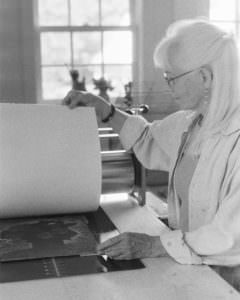
LG: I am a printmaker, painter, and in recent years a quilt-maker. My main printmaking processes are woodcut, etching, and monotype. Through Paper Connection, I was introduced to the Korean paper-felting technique, joomchi, which was a perfect fit for a recent exhibition for the Mark Twain House & Museum of the Printmakers’ Network of Southern New England from March 2022-January 2023.
PC: Are you willing to share insights into your process and current projects?
LG: I admit to being a Yankee, so I hate to waste anything! I began to create paper quilts in order to reuse or recycle parts of woodcut prints that were beautiful, although they had defects that would prohibit them from being part of an edition of prints. By cutting these prints into pattern sections, I have been able to develop a new format for my art.
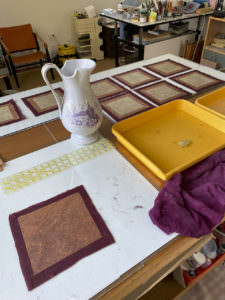
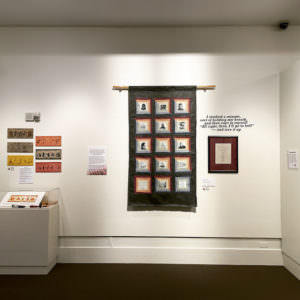
As it turns out, the choice of quilt patterns, and the stitches I have used, strengthen the meaning of the imagery. A perfect example is my quilt for the Mark Twain exhibit called “Uncomfortable Quilt”. I selected the log cabin pattern to be in keeping with the time of Huckleberry Finn, one of my central characters in the quilt. Huck wrestled with the dilemma of whether to turn Jim in as a runaway slave, something his upbringing in a small Missouri town mandated, or to help Jim to freedom as he recognized Jim’s humanity. I felt that Huck’s awakening matched my own as I faced the violence so many African American citizens face at the hands of police. The other individuals represented in my quilt are George Floyd, Freddie Gray, Breonna Taylor, Eric Garner, Tamir Rice, and Michael Brown, who all were brutally killed by police.
As I was stitching the quilt, I realized that the stitches used were consistent with the themes of slavery and freedom as well as our contemporary issue of unjust use of force and the death of African Americans. Serendipity – or subconscious thought – must have guided me to choose the running stitch, the chain stitch, and the whip stitch, which are pretty typical embroidery stitches.
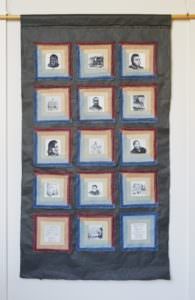
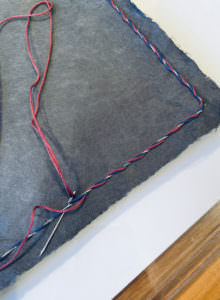
When I was halfway through sewing the quilt together, I realized the connection between subject matter and method. I can tell you, the hair stood up on the back of my neck!
PC: Why do you create? What is the meaning behind your work?
LG: I have always felt compelled to share my human story and to listen and absorb the stories of others. I believe that the arts make us more human. The arts create empathy and understanding among people all over the world, including from past to present lives. I create with the hope that my stories will resonate with people today and in the future.
PC: What influences inspire you and why?
LG: Life in all its beauty inspires me. I feel part of a vast existence of which I am a minuscule part. This helps me to appreciate my insignificance and to feel immense gratitude for the life I have. I hope to inspire my viewers to feel reverence for our world and our shared existence and to pass it forward.
“I realized the connection between subject matter and method. I can tell you, the hair stood up on the back of my neck!”
PC: How did your creative journey bring you to this place?
LG: As part of the Printmakers’ Network of Southern New England, I enjoy the group projects we do. Having been a museum director until 2015, I knew the executive director of the Mark Twain House & Museum in Hartford, CT. I proposed a project idea to the printmakers and then took it with their blessing to the museum. The result was the exhibit called “The Evocative Mark Twain Inspires the Printmakers’ Network of Southern New England.”
The printmakers each chose an authentic quote(s) by Samuel Clemens (aka Mark Twain) and created their own art to reflect their response to the quote. My quote from The Adventures of Huckleberry Finn reflected his struggle with slavery which paralleled my own struggle with the police killings of African American citizens.

For my own piece, I wrote the following wall text:
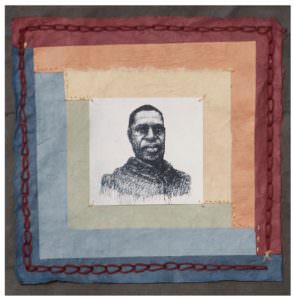
“After George Floyd was murdered by police in Minneapolis in 2020, I experienced an awakening not unlike Huck’s in The Adventures of Huckleberry Finn. I was listening to former RNC chairman Michael Steele as he described “The Conversation” that Black parents have with their children about what to do and say when confronted by the police. Startled, I realized that I had never had this talk with my parents. I had not had this talk with my children. Being white, no one needed to warn me about the danger of being stopped by police. After all, they were good, weren’t they? Maybe not so much…
So began my journey as an artist, producing etchings of George Floyd, Michael Brown, Breonna Taylor, Freddie Gray, Tamir Rice, and Eric Garner. Ultimately, producing etchings from these drawings caused me to feel their humanity deeply and to mourn them.”
PC: Do you ever feel stagnant? If so, how do you break through?
LG: Of course, I have moments of stagnation. Sometimes I find cleaning up my flat files and studio space helps to jump-start me. Sometimes I am renewed by challenging myself to do 100 abstract monotypes, as I did when I retired from my position as Executive Director of the Newport Art Museum. Sometimes, it is just doing some work that is terrible and just pushing through with elbow grease that unlocks my creativity.
PC: Can you describe the importance of paper (or other mediums) in your work, what type of paper (medium) do you use most, and why?
LG: Paper comes from trees. So does the wood I use for woodcuts. There is a connection I feel with the natural world, particularly with trees, so I like to think there is a divine presence guiding me in working with paper.
I do love the feel and the tones of Hahnemühle Copperplate. I also love natural papers such as Lotka from Nepal. I often draw in sketchbooks made of this paper. For the quilt, I used Hanji-(Korean) mulberry paper and Taja white cotton rag.
PC: Why this medium? Can you elaborate/reflect on your work and future forecasting?
LG: I studied printmaking when I was in college, but I was frustrated because the process took so long. I wanted the immediacy of painting. Then in my forties, I returned to printmaking and it was the complexity of the process and the mental dexterity needed to create multi-plate woodcuts and photopolymer etchings that kept me engaged and stimulated ever since. Sometimes life comes full circle.
PC: Are there papers from Paper Connection that you can speak about, provide insights, elaborations, process, and/or integrity of quality?
LG: When I visited Lauren at the Paper Connection in Providence, RI to purchase paper for the quilt, she introduced me to the luscious Korean felting paper called Hanji as well as to the technique of felting itself. This inspired me to try felting. It “felt” right to use in my quilt project. I was able to select shades of red and blue that had equal values as I created the log cabin pattern of dark to light squares. (red for blood and blue for police)
PC: Are there questions no one has asked concerning your creative process, philosophy, or recent experience you’d like to share?
LG: What would life be like if you stopped making art? Would you move to another medium of expression?
PC: Do you have any upcoming shows or installations in progress? If so, please provide info so we can direct our readers.
LG: I am included in a new exhibit of the Printmakers’ Network of Southern New England at the Cahoon Museum of American Art in Barnstable, MA. It runs from April 19-June 18, 2023.
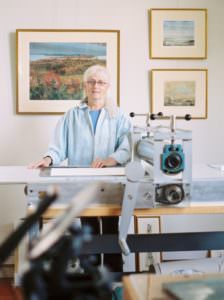 PC: Thank you Lisa! especially for your candid description of your emotional and physical reactions while making the “Uncomfortable Quilt”, made from paper.
PC: Thank you Lisa! especially for your candid description of your emotional and physical reactions while making the “Uncomfortable Quilt”, made from paper.
It has been wonderful to learn about you and your work via your “conversations” with historical figures and influences.
To check out more about Lisa and her artwork, plus her current and past exhibit information, click on the link below.

